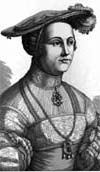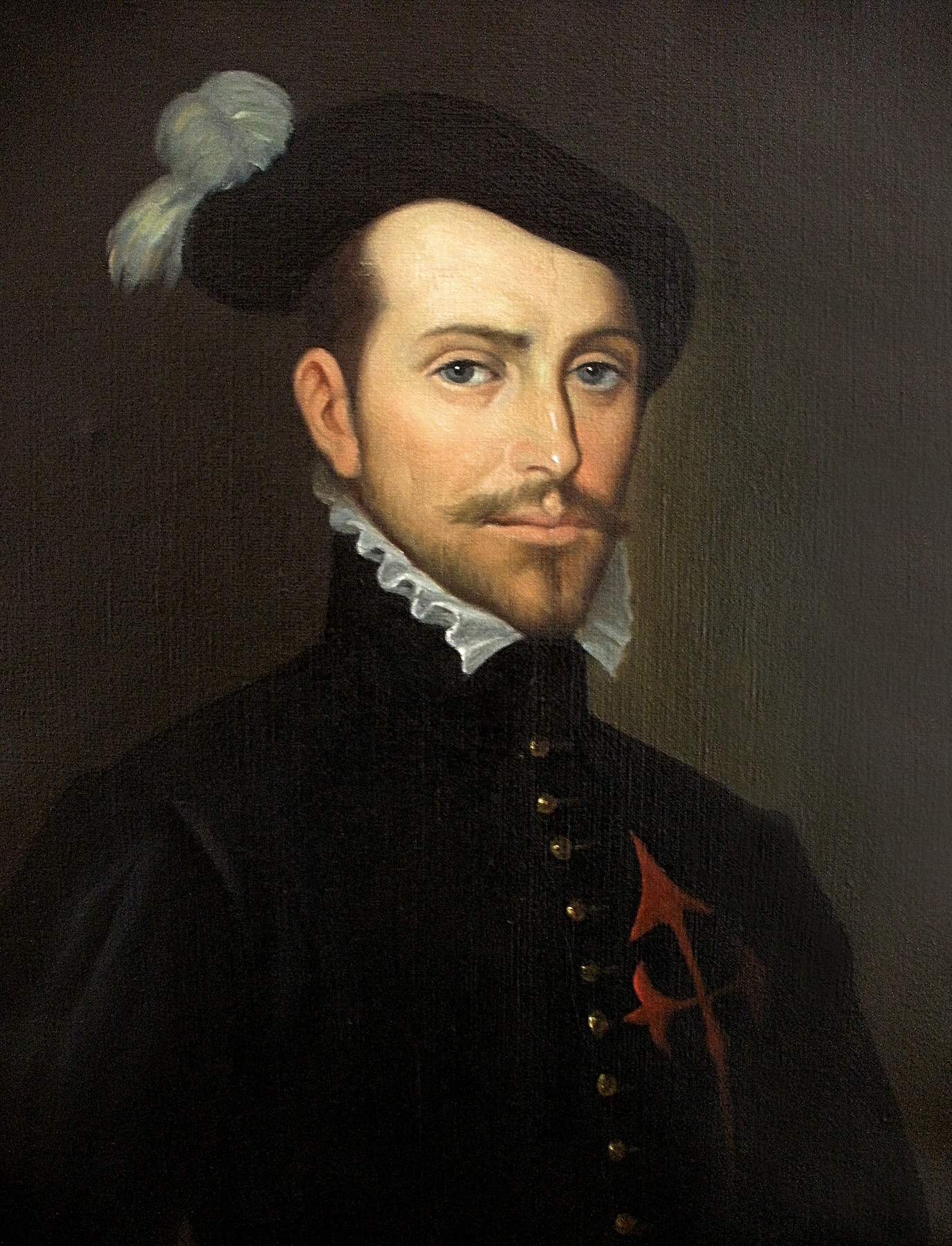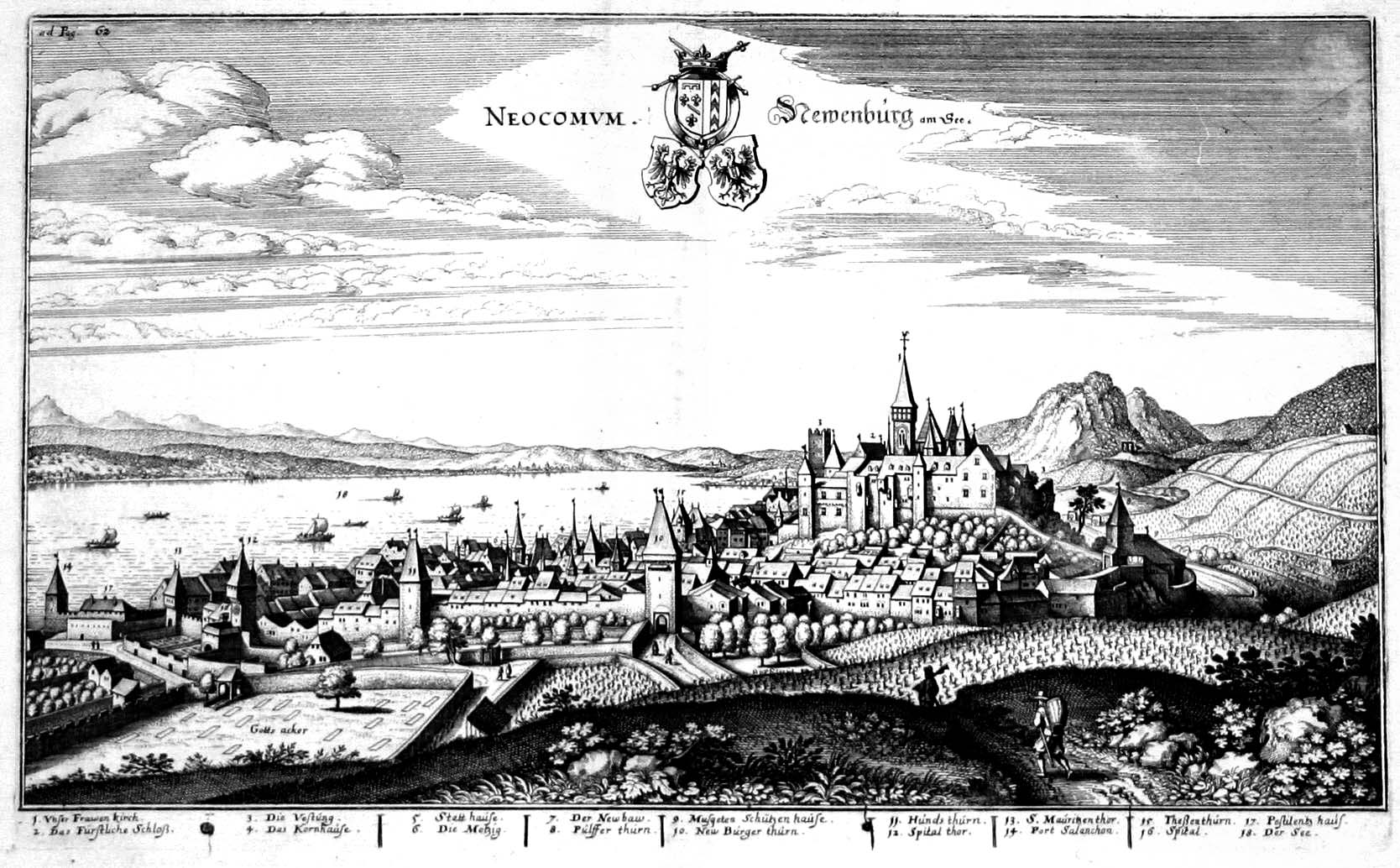|
Johanna Of Hachberg-Sausenberg
Johanna of Hachberg-Sausenberg (1485 – 23 September 1543), was a noble feudal lord, countess regnant of Neuchâtel in 1503–1512 and again from 1529 to 1543. She was the daughter of Philip of Hochberg and Maria of Savoy. Life Johanna inherited the rule of Neuchâtel from her father in 1503. In 1504 she married Louis I d'Orléans, duc de Longueville. As was the custom with female rulers at the time, her husband became her co-ruler. In 1512, Neuchâtel fell under the occupation of the Old Swiss Confederation, as the result of the Pro-French policy of her spouse and co-regent, which was regarded as a security threat to Switzerland. Johanna was actively involved in negotiations with the Swiss cantons to discontinue the occupation and regain access to her county, and when she was widowed in 1516 her position in the negotiations improved. The occupation of Neuchâtel was discontinued in 1529, and she was able to resume her reign. Issue * Claude (1508 – November 9, 1524), Duke ... [...More Info...] [...Related Items...] OR: [Wikipedia] [Google] [Baidu] |
Portrait De Jeanne De Hochberg
A portrait is a portrait painting, painting, portrait photography, photograph, sculpture, or other artistic representation of a person, in which the face and its expressions are predominant. The intent is to display the likeness, Personality type, personality, and even the mood of the person. For this reason, in photography a portrait is generally not a Snapshot (photography), snapshot, but a composed image of a person in a still position. A portrait often shows a person looking directly at the painter or photographer, in order to most successfully engage the subject with the viewer. History Prehistorical portraiture Plastered human skulls were reconstructed human skulls that were made in the ancient Levant between 9000 and 6000 BC in the Pre-Pottery Neolithic B period. They represent some of the oldest forms of art in the Middle East and demonstrate that the prehistoric population took great care in burying their ancestors below their homes. The skulls denote some of the earlie ... [...More Info...] [...Related Items...] OR: [Wikipedia] [Google] [Baidu] |
Léonor D'Orléans, Duc De Longueville
Léonor d'Orléans, duc de Longueville (1540 – 7 August 1573) was prince de Châtellaillon, marquis de Rothelin, comte de Montgommery et Tancarville, viscomte d'Abbeville, Melun, comte de Neufchâtel et Valangin. Longueville was governor of Picardy, the leader of one of the Prince étranger families of France and a descendant of the bastard of Orléans who was in turn a descendant of Charles V of France. By Longueville's time his family was close to that of another princely house, that of the Guise, the Guise had controlled much of his family's estates during the life of his cousin, but when he died in 1551 the title of Longueville reverted to Léonor, and his mother championed his re-acquisition of the family estates. He fought in the later Italian Wars serving at the battle of Saint-Quentin in which he was captured. Close to the Guise, he received little help from court in paying off his ransom, but his mother petitioned the Guise to help him, who obliged. His mother, Jacq ... [...More Info...] [...Related Items...] OR: [Wikipedia] [Google] [Baidu] |
1543 Deaths
__NOTOC__ Year 1543 ( MDXLIII) was a common year starting on Monday (link will display the full calendar) of the Julian calendar. It is one of the years sometimes referred to as an "Annus mirabilis" because of its significant publications in science, considered the start of the scientific revolution. Events January–June * February 11 – King Henry VIII of England allies with Charles V, Holy Roman Emperor, against France. * February 21 – Battle of Wayna Daga: A joint Ethiopian-Portuguese force of 8,500, under Emperor Gelawdewos of Ethiopia, defeats Imam Ahmad ibn Ibrahim al-Ghazi's army of over 14,000, ending the Ethiopian–Adal war. * March ** King Gustav Vasa's troops crush the forces of Swedish peasant rebel Nils Dacke in battle, ending the uprising. Dacke escapes, but is captured and killed in the summer. ** Consolidating Act of Welsh Union: The Parliament of England establishes counties and regularises parliamentary representation in Wales. * April &nd ... [...More Info...] [...Related Items...] OR: [Wikipedia] [Google] [Baidu] |
1485 Births
Year 1485 ( MCDLXXXV) was a common year starting on Saturday (link will display the full calendar) of the Julian calendar. Events January–December * Spring – Multiple earthquakes occur near Taishan, China. * March 16 – A solar eclipse crosses northern South America and Central Europe. * June 1 – Matthias of Hungary takes Vienna, in his conquest of Austria (from Frederick III), and makes the city his capital. * August 5–August 7 – The first outbreak of sweating sickness in England begins. * August 22 – Battle of Bosworth: King Richard III of England is defeated by (rival claimant to the throne of England) Henry Tudor, Earl of Richmond; Richard dies in battle, and Henry Tudor becomes King Henry VII of England (although Henry marks this battle as August 21, so that he can declare all his opponents traitors). * September 12 – Muscovian forces conquer Tver. * September 15 – Peter Arbues is assaulted while praying in the ca ... [...More Info...] [...Related Items...] OR: [Wikipedia] [Google] [Baidu] |
François III D'Orléans, Duke Of Longueville
François III de Longueville (1535–1551) was the eldest son of Louis II d'Orléans, Duke of Longueville and Marie de Guise. He succeeded his father, who died on 9 June 1537, to the duchy of Longueville. Life François was born on 30 October 1535 His mother, Marie de Guise, was from the powerful French Catholic House of Guise. His father, Louis, was the son of Louis I d'Orleans, Duke of Longueville. Following his father's death and his mother's marriage to James V of Scotland, François' care was entrusted to his grandmother, Antoinette de Bourbon. Francis kept correspondence with his mother, sending her a piece of string to show how tall he was, and later his portrait. By 1550 François was ill. His mother had returned to France as part of the betrothal of his half-sister Mary Mary may refer to: People * Mary (name), a feminine given name (includes a list of people with the name) Religious contexts * New Testament people named Mary, overview article linking to many of ... [...More Info...] [...Related Items...] OR: [Wikipedia] [Google] [Baidu] |
Principality Of Neuchâtel
A principality (or sometimes princedom) can either be a monarchical feudatory or a sovereign state, ruled or reigned over by a regnant-monarch with the title of prince and/or princess, or by a monarch with another title considered to fall under the generic meaning of the term ''prince''. Terminology Most of these states have historically been a polity, but in some occasions were rather territories in respect of which a princely title is held. The prince's estate and wealth may be located mainly or wholly outside the geographical confines of the principality. Generally recognised surviving sovereign principalities are Liechtenstein, Monaco, and the co-principality of Andorra. Extant royal primogenitures styled as principalities include Asturias (Spain). The Principality of Wales existed in the northern and western areas of Wales between the 13th and 16th centuries; the Laws in Wales Act of 1536 which legally incorporated Wales within England removed the distinction between t ... [...More Info...] [...Related Items...] OR: [Wikipedia] [Google] [Baidu] |
Philippe, Duke Of Nemours
Philip of Savoy, Duke of Nemours (149025 November 1533) was a French nobleman. He was a son of Philip II, Duke of Savoy, and his second wife Claudine de Brosse. He was a half-brother of Louise of Savoy, the mother of Francis I of France. He was the founder of the Nemours branch of the house of Savoy which eventually settled in France. Originally destined for the priesthood, he was given the bishopric of Geneva at the age of five, but resigned it in 1510, when he was made count of Genevois. He served under Louis XII, with whom he was present at the battle of Agnadello (1509), under the emperor Charles V in 1520, and finally under his nephew, Francis I. In 1528 Francis gave him the duchy of Nemours and married him to Charlotte of Orleans, a daughter of Louis d'Orléans, Duke of Longueville. They had two children: * Joanna (1532–1568), who married Nicolas, Duke of Mercœur as his second wife, and had 6 children with him, and * Jacques, Duke of Nemours Jacques de Savoie, duc d ... [...More Info...] [...Related Items...] OR: [Wikipedia] [Google] [Baidu] |
Jacqueline De Rohan, Marquise De Rothelin
Jacqueline de Rohan, Marquise de Rothelin (c. 1520 – 1587) was a French court official and aristocrat. She was the daughter of Charles de Rohan and Jeanne de Saint-Severin, and regent of the Neufchâtel and of Valangin during the minority of her son Leonor, Duke de Longueville, Duke d' Estouteville. Biography Her paternal grandparents were Pierre de Rohan, Viscount de Fronsac and Françoise de Penhoet. Her maternal grandparents were Bernard de Saint-Severin, Prince of Besignano, and Jeanne Eléonore Piccolomini. The latter was a descendant of King Alfonso V of Aragon and his mistress Giraldona Carlino. She served as lady-in-waiting to both Eleanor of Austria (fille d'honneur 1531-1536 and Dame d'honneur 1538-1543) and Catherine de Medici. Her husband, Francois of Orleans-Longueville, Marquis de Rothelin, died on 25 October 1548, and in watching her son Leonor's interests in Neuchâtel she was brought into contact with the reformers in Switzerland. She then embraced Protestant ... [...More Info...] [...Related Items...] OR: [Wikipedia] [Google] [Baidu] |
Neuchâtel
, neighboring_municipalities= Auvernier, Boudry, Chabrey (VD), Colombier, Cressier, Cudrefin (VD), Delley-Portalban (FR), Enges, Fenin-Vilars-Saules, Hauterive, Saint-Blaise, Savagnier , twintowns = Aarau (Switzerland), Besançon (France), Sansepolcro (Italy) Neuchâtel (, , ; german: Neuenburg) is the capital of the Swiss canton of Neuchâtel, situated on the shoreline of Lake Neuchâtel. Since the fusion in 2021 of the municipalities of Neuchâtel, Corcelles-Cormondrèche, Peseux, and Valangin, the city has approximately 45,000 inhabitants (80,000 in the metropolitan area). The city is sometimes referred to historically by the German name ; both the French and German names mean "New Castle". It was originally part of the Kingdom of Burgundy, then part of the Holy Roman Empire and later under Prussian control from 1707 until 1848, with an interruption during the Napoleonic Wars from 1802 to 1814. In 1848, Neuchâtel became a republic and a canton of Switzerland. Neuch� ... [...More Info...] [...Related Items...] OR: [Wikipedia] [Google] [Baidu] |
Mary Of Guise
Mary of Guise (french: Marie de Guise; 22 November 1515 – 11 June 1560), also called Mary of Lorraine, was a French noblewoman of the House of Guise, a cadet branch of the House of Lorraine and one of the most powerful families in France. She was Queen of Scotland from 1538 until 1542, as the second wife of King James V. As the mother of Mary, Queen of Scots, she was a key figure in the political and religious upheaval that marked mid-16th-century Scotland, ruling the kingdom as regent on behalf of her daughter from 1554 until her death in 1560. The eldest of the twelve children born to Claude, Duke of Guise, and Antoinette de Bourbon, in 1534 Mary was married to Louis II d'Orléans, Duke of Longueville, the Grand Chamberlain of France. The marriage was arranged by King Francis I of France, but proved shortlived. The Duke of Longueville died in 1537, and the widower kings of England and Scotland, Henry VIII and James V, both sought the Duchess of Longueville's hand. After mu ... [...More Info...] [...Related Items...] OR: [Wikipedia] [Google] [Baidu] |
Louis II D'Orléans, Duke Of Longueville
Louis II d'Orléans, duc de Longueville and comte de Dunois (1510 – 9 June 1537) was a French aristocrat and the first husband of Mary of Guise, who later became queen consort of Scotland and mother to Mary, Queen of Scots. He was the second son of Louis I d'Orléans, duc de Longueville by his wife Jeanne of Hochberg, and succeeded his brother Claude when the latter died in 1524. He married Mary of Guise on 4 August 1534 at the Louvre Palace. During their brief marriage, the couple had two children: *François, born 30 October 1535, who would later succeed to the dukedom *Louis, a posthumous child born 4 August 1537, who died four months later. Louis died at Rouen on 9 June 1537, Mary would later marry James V of Scotland James V (10 April 1512 – 14 December 1542) was List of Scottish monarchs, King of Scotland from 9 September 1513 until his death in 1542. He was crowned on 21 September 1513 at the age of seventeen months. James was the son of James IV of Sco .... An ... [...More Info...] [...Related Items...] OR: [Wikipedia] [Google] [Baidu] |







_as_Duchess_of_Longueville.png)